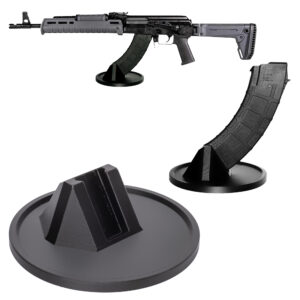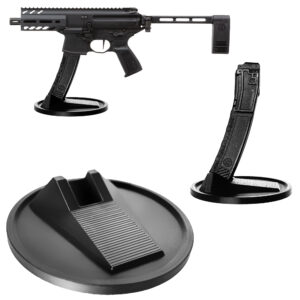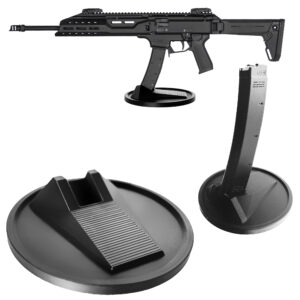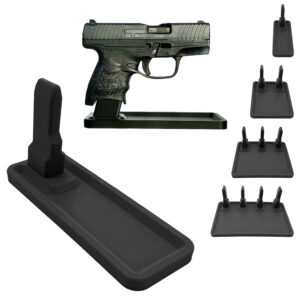
Categories:
Gun magazines are an integral part of guns, serving as the ammunition feeding device that allows shooters to fire multiple rounds without the need for frequent reloading. These vital components come in various sizes and capacities, designed to cater to different shooting needs and preferences. Two common types of gun magazines are standard capacity and extended capacity magazines. In this article, we will delve into the significance of gun magazines, explore the differences between standard and extended capacity options, and shed light on their implications for gun enthusiasts.
Gun magazines play a crucial role in ensuring a shooter’s ability to engage targets efficiently. They allow for rapid-fire capabilities by storing cartridges or rounds securely within the magazine’s casing before they are fed into the gun’s chamber. This eliminates the need for manually inserting individual rounds after every shot, streamlining the shooting process. Standard capacity magazines, as their name suggests, are designed with a typical number of rounds that align with a gun’s original specifications or industry standards.
These magazines usually hold between 10 to 17 rounds for handguns and up to 30 rounds for rifles. On the other hand, extended capacity magazines offer higher round counts beyond what is considered standard. They may accommodate 20 or more additional rounds compared to their standard counterparts. The debate surrounding standard versus extended capacity gun magazines often revolves around issues such as self-defense effectiveness, practicality in specific scenarios like law enforcement or military operations, and even concerns about public safety.
Understanding both types of gun magazines is essential not only for gun enthusiasts but also policymakers tasked with crafting legislation related to guns. In subsequent sections of this article, we will explore these perspectives further while examining factors such as reliability, ease of use, legal considerations, and potential impacts on self-defense situations when choosing between standard versus extended capacity gun magazines.
When it comes to guns, one of the key components that often sparks debate among gun enthusiasts is the magazine capacity. Magazines play a crucial role in determining how many rounds a gun can hold before needing to be reloaded. In this regard, two common types of gun magazines are standard and extended capacity magazines. While both serve the purpose of storing ammunition for guns, there are distinct differences between them.
Standard capacity magazines, as the name suggests, refer to the magazines that come with most guns from the manufacturer. These magazines are designed to hold a specific number of rounds that are considered standard for that particular gun model. The capacity may vary depending on the type of gun and its intended use but typically ranges from 5 to 20 rounds for handguns and up to 30 rounds for rifles or carbines.
On the other hand, extended capacity magazines go beyond these limitations and offer a higher round count compared to their standard counterparts. These magazines are specifically designed to accommodate more ammunition than what is considered standard for a particular gun model. Extended capacity magazines can hold anywhere from 30 rounds or more for handguns and up to 100 rounds or even higher for rifles.
The primary advantage of extended capacity magazines is obvious – they allow shooters to fire more rounds without having to reload as frequently. This can be particularly advantageous in certain scenarios such as self-defense situations or competitive shooting events where quick follow-up shots might be necessary.
However, it is important to note that extended capacity magazines have also been subject to controversy due to their potential association with increased lethality in mass shootings. Consequently, laws governing these types of magazines vary across different jurisdictions.
In summary, while both standard and extended capacity gun magazines have their own merits depending on individual needs and circumstances, understanding their differences is crucial when it comes to making informed decisions regarding magazine selection for guns.
Standard capacity gun magazines, also known as “factory” or “original equipment manufacturer” (OEM) magazines, have been the go-to choice for many gun owners for various reasons. While extended capacity magazines may offer increased ammunition capacity, standard capacity magazines possess their own unique advantages that make them a preferred option for some gun enthusiasts. 1. Concealability: One significant advantage of standard capacity magazines is their compact size and ease of concealment.
These magazines are designed to fit flush with the grip of the gun, maintaining a sleek and streamlined profile. This makes them ideal for concealed carry purposes where discretion is crucial. Extended capacity magazines tend to protrude from the grip, making it harder to conceal the weapon effectively. 2. Enhanced Maneuverability: Standard capacity magazines contribute to improved maneuverability by keeping the gun lightweight and well-balanced.
The weight distribution remains centered around the grip, allowing for greater control during rapid target acquisition and quick follow-up shots. Extended capacity magazines can add significant weight to a gun’s overall balance, potentially affecting accuracy and handling. 3. Reliability: OEM manufacturers meticulously design standard capacity magazines specifically tailored to each gun model they produce. These magazines undergo rigorous testing and are built using high-quality materials, ensuring reliable feeding and function in a wide range of conditions.
In contrast, aftermarket extended capacity magazines may vary in quality and compatibility with different guns, increasing the risk of malfunctions or feeding issues. 4. Legal Compliance: In many jurisdictions, there are restrictions on magazine capacities that civilians can possess legally. Standard capacity gun magazines often meet these legal requirements without necessitating any modifications or additional permits from authorities.
Standard capacity gun magazines, typically holding 10 to 15 rounds, have long been the norm in the guns industry. While they serve their purpose adequately for many shooters, there are several limitations associated with these magazines that warrant consideration.
1. Limited Firepower: The most obvious limitation of standard capacity gun magazines is their limited firepower. With fewer rounds available, shooters may find themselves reloading more frequently, especially in scenarios where a high volume of fire is required. This can be particularly disadvantageous in self-defense situations or when engaging multiple targets simultaneously.
2. Reduced Efficiency: Reloading takes time and can hinder a shooter’s ability to engage threats effectively. Standard capacity magazines necessitate frequent reloads which interrupt the flow of shooting and increase the risk of malfunctions or errors during high-pressure situations.
3. Tactical Disadvantage: In tactical engagements, having an extended amount of ammunition readily available is crucial for maintaining an advantage over adversaries. Standard capacity magazines can put users at a disadvantage by limiting their ability to sustain fire or suppress enemy positions without interruption.
4. Competitive Shooting Constraints: In competitive shooting disciplines such as IPSC or USPSA, where speed and accuracy are paramount, standard capacity magazines may limit a shooter’s performance potential due to the frequent need for reloads. These moments can result in crucial time penalties that affect overall scores.
5. Limited Flexibility: Lastly, standard capacity gun magazines restrict customization options for gun owners who wish to modify their weapons with accessories such as grips or extended magazine wells. The size constraints imposed by standard magazines often prevent shooters from fully optimizing their guns according to personal preferences and requirements.
While standard capacity gun magazines remain functional for many purposes and legal requirements in certain jurisdictions, these limitations should be acknowledged when assessing their suitability for specific applications or individual needs within the guns community.
Extended capacity gun magazines, also known as high-capacity or large-capacity magazines, have gained significant popularity among gun enthusiasts and professional shooters. These magazines offer several notable benefits that make them a preferred choice for many individuals. 1. Increased Ammunition Capacity: One of the most obvious advantages of extended capacity gun magazines is their ability to hold more rounds compared to standard magazines.
This increased ammunition capacity provides shooters with a greater number of shots before needing to reload. In situations where every second counts, such as self-defense or competitive shooting, having additional rounds readily available can make a crucial difference. 2. Enhanced Firepower: With extended capacity magazines, shooters can unleash a higher volume of fire without interruption. This is particularly advantageous in scenarios where engaging multiple targets or suppressing enemy fire is necessary.
The increased firepower can provide an undeniable advantage in tactical situations and military operations. 3. Reduced Reload Frequency: By holding more rounds, extended capacity magazines minimize the need for frequent reloading during shooting sessions or critical situations. This not only saves valuable time but also reduces the risk of fumbling with reloading procedures under pressure, ensuring smoother and uninterrupted shooting experiences.
4. Improved Confidence and Peace of Mind: Knowing that they have more rounds at their disposal instills confidence in shooters, especially those who rely on guns for personal protection or participate in high-pressure shooting competitions. The psychological aspect of feeling adequately armed can contribute to improved performance and peace of mind. 5. Versatility: Extended capacity magazines are available for a wide range of guns, including handguns and rifles, allowing shooters to customize their weapons according to their specific needs and preferences.
This versatility enables users to adapt their guns for various purposes such as home defense, sport shooting disciplines like IPSC (International Practical Shooting Confederation), or even hunting larger game.
While extended capacity gun magazines may seem appealing to some gun enthusiasts and professionals, it is important to consider the drawbacks associated with their use. These drawbacks can have significant implications for both the user and society as a whole. One of the primary concerns with extended capacity magazines is their potential to increase the lethality of mass shootings and criminal activities.
By allowing shooters to fire more rounds without reloading, these magazines enable a higher rate of fire, making it easier for individuals to cause extensive harm in a short period. This poses a serious threat to public safety as law enforcement and civilians may struggle to respond effectively in such situations. Moreover, extended capacity magazines can lead to increased user error due to their bulkier size and weight.
Handling guns equipped with these magazines can become more cumbersome, affecting accuracy and control. This is especially problematic for those who rely on guns for self-defense purposes or professional use as any loss of accuracy may jeopardize their safety or that of others. Another drawback worth considering is the potential impact on ammunition supply chains. The demand for larger-capacity magazines often leads to an increased demand for ammunition, which can strain manufacturers’ ability to keep up with production.
In turn, this could result in shortages or inflated prices, making it harder for law-abiding citizens who rely on guns for protection or recreational purposes to access necessary ammunition. Lastly, from a legal perspective, extended capacity magazines face stricter regulations in many jurisdictions due to concerns surrounding public safety. Their possession may be subject to restrictions or outright bans in certain areas, limiting the choices available for law-abiding gun owners who wish to exercise their Second Amendment rights responsibly.
In conclusion, while extended capacity gun magazines offer certain advantages in terms of firepower and convenience, they come with significant drawbacks that need careful consideration.
The debate surrounding standard versus extended capacity gun magazines is not only a matter of personal preference but also subject to various legal considerations. While the laws regarding magazine capacities vary across jurisdictions, it is essential for gun owners to be aware of the regulations in their respective regions.
In some countries and states, there are strict limitations on magazine capacities. These restrictions aim to enhance public safety by reducing the number of rounds a shooter can fire without reloading. For instance, in certain European countries like Germany and France, civilian ownership of high-capacity magazines is generally prohibited. Similarly, several US states have implemented laws that restrict magazine capacities to a specific number of rounds.
California, for example, limits handguns to ten-round magazines.
However, other jurisdictions have more lenient regulations regarding magazine capacities. In some US states with less restrictive gun laws, there may be no specific limits on magazine sizes for guns owned by civilians. This approach allows individuals to exercise their Second Amendment rights without interference from the government.
It is crucial for gun owners to understand the legal implications associated with their choice of magazine capacity and abide by local regulations. Failure to comply with these laws can result in severe consequences such as fines, imprisonment, or even loss of gun ownership privileges.
Moreover, it is worth noting that legal considerations surrounding magazine capacities are subject to change over time. As lawmakers continuously assess public safety concerns and respond to evolving societal needs, it becomes imperative for gun enthusiasts and owners alike to stay informed about any amendments or updates in legislation.
Ultimately, responsible gun ownership entails not only understanding how different types of magazines function but also respecting and adhering to the relevant legal frameworks set forth by authorities within one’s jurisdiction.
Selecting the appropriate magazine capacity is a crucial decision when it comes to guns, as it directly impacts your tactical and practical applications. Whether you opt for standard or extended capacity gun magazines, understanding their advantages and limitations is essential for making an informed choice.
Standard capacity magazines are typically designed to hold the manufacturer-specified number of rounds for a specific gun. These magazines offer several practical benefits, such as being more compact and lightweight compared to extended capacity alternatives. They are often preferred in situations where concealment or ease of movement is a priority, such as concealed carry or close-quarters combat scenarios. Additionally, standard capacity magazines can enhance weapon balance and maneuverability, enabling quick target acquisition and rapid reloads.
On the other hand, extended capacity gun magazines provide shooters with increased ammunition capacity beyond the standard specifications. These magazines are particularly advantageous in situations that require sustained fire or prolonged engagements. Law enforcement officers on patrol or military personnel in combat zones may find extended capacity magazines invaluable due to their ability to hold more rounds before requiring a reload.
However, it’s important to consider certain factors before deciding on an extended capacity magazine. The additional ammunition can lead to increased weight and bulkiness, affecting weapon handling and potentially compromising maneuverability in tight spaces. Moreover, depending on local regulations, these high-capacity magazines may not be legal for civilian use or might have restrictions on their usage.
Choosing between standard and extended capacity gun magazines ultimately depends on your intended application and requirements. Evaluate factors such as mission objectives, concealability needs, potential engagement distances, legal considerations, and personal preferences when making this decision. By carefully assessing these aspects of your situation, you can make an informed choice that optimizes both tactical effectiveness and practicality based on your unique needs.
When it comes to gun magazines, there is a wide range of options available in the market today. Different brands offer various models, each catering to specific needs and preferences of gun enthusiasts. This subtopic aims to explore some popular brands and models for both standard and extended capacity magazines. Glock, a well-known name in the guns industry, offers a range of magazines that are widely used by gun owners.
The Glock OEM magazines, such as the Glock 17 magazine (standard capacity) or the Glock 19 magazine (compact size), are known for their reliability and durability. These magazines often come with a high-quality polymer construction, making them lightweight yet robust. Another reputable brand is Magpul Industries, which is highly regarded for producing innovative gun accessories. Their PMAG series has gained immense popularity among gun enthusiasts due to its exceptional performance and versatility.
The PMAGs are available in various capacities, including both standard and extended options. Smith & Wesson also offers a range of reliable magazines suitable for their handguns. The M&P series magazines are known for their durability and compatibility with different pistol models like the M&P Shield or M&P Compact. For those seeking extended capacity options specifically designed for self-defense purposes or competitive shooting sports, manufacturers like ETS Group or SureFire have gained recognition.
ETS Group manufactures translucent polymer magazines that allow users to easily monitor ammunition levels at a glance. SureFire offers high-capacity magazines with advanced features such as anti-tilt followers that ensure smooth feeding under any condition. In conclusion, there is no shortage of choices when it comes to standard and extended capacity gun magazines.
In conclusion, when it comes to choosing between standard and extended capacity gun magazines, there are several factors that need to be considered. Both options have their own advantages and disadvantages, depending on the specific needs and circumstances of the user.
Standard capacity magazines offer reliability, ease of use, and better concealment for those who prioritize discretion or have limited space for carrying additional ammunition. They are also generally more affordable and widely available. However, they may require more frequent reloading in high-intensity situations or self-defense scenarios.
On the other hand, extended capacity magazines provide a larger number of rounds without having to reload as frequently. This can be beneficial in situations where a higher volume of fire is necessary or when engaging multiple targets. However, they can be bulkier and heavier, making them less suitable for concealed carry or when mobility is crucial.
It is essential to assess individual needs and consider legal regulations governing magazine capacities in your area before making a decision. Furthermore, training and experience play a significant role in effectively utilizing either type of magazine. Proper training ensures that the user understands reloading techniques, firing discipline, and ammo management regardless of magazine capacity.
Ultimately, the choice between standard and extended capacity gun magazines should be based on personal preferences as well as intended use. A thorough evaluation of one’s requirements in terms of firepower needed during potential encounters or shooting activities will aid in making an informed decision.
Remember that responsible gun ownership involves understanding local laws regarding magazine capacities while prioritizing safety above all else. Regardless of the chosen option—standard or extended—proper handling techniques combined with regular practice are crucial for maintaining proficiency with guns equipped with either type of magazine.








Colt
Colt M4 Carbine
Colt LE6920
Colt AR-15 A4
Daniel Defense
DDM4 V7
DDM4 V9
DDM4 V11
DDM4 ISR (Integrally Suppressed Rifle)
Smith & Wesson (S&W)
M&P15 Sport II
M&P15 Tactical
M&P15T
Bravo Company Manufacturing (BCM)
BCM Recce-16
BCM Recce-14
BCM MCMR Series
Aero Precision
M4E1 Series
AC-15
AR15 Pistol (Various Configurations)
Ruger
Ruger AR-556
Ruger SR-556
Ruger AR-556 MPR (Multi-Purpose Rifle)
Springfield Armory
Saint Victor
Saint Edge
Saint AR-15
PSA (Palmetto State Armory)
PSA PA-15
PSA AR-V
PSA Jakl (AR Pistol)
FN America
FN 15 Tactical Carbine
FN 15 Patrol
FN 15 DMR
Wilson Combat
Recon Tactical
Super Sniper
Protector Carbine
SIG Sauer
SIG M400 Tread
SIG M400 Elite
SIG M400 SDI
LWRC International
IC DI (Direct Impingement)
IC SPR
IC A5
Bushmaster Guns
XM-15 QRC
Bushmaster MOE
XM-15 Patrolman
Rock River Arms
LAR-15 Entry Tactical
LAR-15 Predator
LAR-15 Elite Comp
Stag Arms
Stag 15 Tactical
Stag 15L (Left-Handed Models)
Stag 15 Valkyrie
Noveske Rifleworks
Noveske Gen 4 N4
Noveske Space Invader (AR Pistol)
Noveske Recon
Anderson Manufacturing
AM-15 Optic Ready
AM-15 M4 Carbine
AM-15 Precision Rifle
Adams Arms
AA-15 Piston Rifle
P2 AARS (Adams Arms Rifle Series)
Black Rain Ordnance
SPEC15 Series
BRO Predator
Fallout 15
Diamondback Guns
DB15 Series
DB15CCMLB
DB15EB
Del-Ton Inc.
DTI-15
Del-Ton Echo 316H
Sierra 316M
Windham Weaponry
Windham SRC
Windham VEX-SS
Windham RMCS-4 (Caliber Conversion System)
Christensen Arms
CA-15 G2
CA-15 Recon
CA-15 Titanium Edition
Patriot Ordnance Factory (POF-USA)
Renegade Plus
P415 Edge
Revolution DI
LaRue Tactical
PredatAR
OBR (Optimized Battle Rifle)
LaRue Stealth 2.0
Battle Arms Development
Workhorse Patrol Carbine
BAD556-LW (Lightweight)
Authority Elite Rifle
Faxon Guns
Ascent AR-15
FX-19 (AR Pistol)
Streamline Ultralight Series
KE Arms
KE-15 SLT (Super Lightweight Tactical)
KE-15 Scout Carbine
Primary Weapons Systems (PWS)
MK1 MOD 2-M
MK116 PRO
MK107 (Piston AR Pistol)
ZEV Technologies
ZEV Core Elite Rifle
ZEV AR15 Billet Rifles
Franklin Armory
BFSIII AR-C1
Militia Model
F17-L (Chambered in .17 WSM)
Seekins Precision
SP15 DMR
NX15 Skeletonized Rifle
Havak Bravo
Aero Precision (Additional Models)
EPC-9 (Pistol Caliber ARs)
VG6 AR Rifles
Barrett Guns
REC7 DI
REC7 Gen II
CMMG
MK4 RCE
Resolute 300
Banshee (AR Pistol)
DPMS Panther Arms
Panther Oracle
Panther LR-308
H&K (Heckler & Koch)
HK MR556A1
HK416 (Military Variant)
Rock Island Armory (Armscor)
VR-80 Tactical AR (Shotgun AR Platform)
Troy Industries
Troy SPC-A3
Troy PAR (Pump Action AR)
Wilson Tactical
Tactical Recon AR
Protector Series
F1 Guns
FDR-15 Skeletonized Rifle
BDRx-15 Series
Juggernaut Tactical
JT-15
JT-10 Precision Rifle
AeroSurplus
Surplus AR-15 Rifles (Budget Models)
Thunder Tactical
AR-15 Basic Carbine
Tactical Builder Sets
Radical Guns
RF-15
Forged AR-Series
Dark Storm Industries
DS-15 Featureless Rifles
DS-10 Typhoon
DRD Tactical
Paratus
Aptus AR Rifles
Bear Creek Arsenal
BCA-15
AR Complete Upper Builds
Aero Survival Rifles (ASI)
ASR Tactical Series
Tactical Edge
WARFIGHTER Series
AR-15 Lightweight Rifles
Lone Star Armory
TX15 DMR
TX15 Carbine
HERA Arms
HERA H7
HERA AR-15 Lower Builds
IWI (Israeli Weapon Industries)
Zion-15
DRD Tactical
Tactical Modular Rifles
Quick-Takedown Rifles
V Seven Weapons
1776 Rifle
Hyperlite Rifle
Core Rifle Systems
Core15 Tac III
Core15 Patrol Rifle
Armalite (Original AR-15 Creator)
M15 Tactical
M15 A4 Carbine
DEF15 (Defensive Sporting Rifle Series)
PSA (Palmetto State Armory Additional Models)
PSAK-47 Hybrid (AR-AK Style Hybrid)
PSA Dagger (Pistol Caliber Configurations)
Odin Works
OTR-15
Odin Recon Rifle
Maxim Defense
MDX-508 PDX (Compact AR Pistol)
MDX-510 Rifle